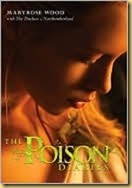 I have to say I’m not sure how I feel about this one. I liked the beginning: Jessamine keeps a diary of her lonely life with her father in a remote cottage in Northumberland. Her father, Thomas Luxton, isn’t a doctor, or a butcher (what he calls surgeons), but when people are sick, they send for him He is called an apothecary, but he considers himself a gardener, nevermind that many of the plants he grows are poisonous. In fact, he has a special walled garden that’s kept locked, which is full of all varieties of poisonous plants. Jessamine’s life changes when the local owner of an insane asylum drops off a strange, orphaned teenaged boy who’s accused of curing the inmates of their madness. It’s hard to believe that in that time period (late 18th century?) Jessamine’s father would have left her alone in the cottage for days at a time with a boy her own age, but it’s more believable when you realize later in the story that he has nefarious plans for them. Thomas Luxton would give anything to learn ancient secrets of healing plants that have been lost through the ages, and it appears that the foundling boy, Weed, somehow has that knowledge. The story gets pretty wild, but it’s certainly suspenseful. I would have to call this a fantasy since the plants talk to weed, and Prince Oleander, the Prince of Poison, is masterminding it all. Review by Stacy Church
I have to say I’m not sure how I feel about this one. I liked the beginning: Jessamine keeps a diary of her lonely life with her father in a remote cottage in Northumberland. Her father, Thomas Luxton, isn’t a doctor, or a butcher (what he calls surgeons), but when people are sick, they send for him He is called an apothecary, but he considers himself a gardener, nevermind that many of the plants he grows are poisonous. In fact, he has a special walled garden that’s kept locked, which is full of all varieties of poisonous plants. Jessamine’s life changes when the local owner of an insane asylum drops off a strange, orphaned teenaged boy who’s accused of curing the inmates of their madness. It’s hard to believe that in that time period (late 18th century?) Jessamine’s father would have left her alone in the cottage for days at a time with a boy her own age, but it’s more believable when you realize later in the story that he has nefarious plans for them. Thomas Luxton would give anything to learn ancient secrets of healing plants that have been lost through the ages, and it appears that the foundling boy, Weed, somehow has that knowledge. The story gets pretty wild, but it’s certainly suspenseful. I would have to call this a fantasy since the plants talk to weed, and Prince Oleander, the Prince of Poison, is masterminding it all. Review by Stacy Church
An online club for teens to talk about books, movies, TV shows, music, magazines and video games
Friday, April 29, 2011
Review of The Poison Diaries by Maryrose Wood
Review of Trash by Andy Mulligan

Saturday, April 23, 2011
Review of Bamboo People by Mitali Perkins

Friday, April 22, 2011
Review of Life, After by Sarah Darer Littman
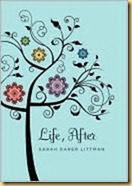 Life, After is a window into a culture and time period that I knew almost nothing about –Argentina during “the Crisis" in the late 1990’s, when the nation’s banks failed. People left Argentina after losing everything, many of them were Jews who emigrated to Israel, or the US. Dani’s home life is miserable –her mother works long hours at the hospital to try to support the family after they lost the family business. Her father is depressed, and only comes out of his depression to yell at Dani and her younger sister. Her aunt died in a terrorist bombing when Dani was 7, and her father has never gotten over it. Dani’s best friend left for Israel. She does have a boyfriend (her novio), but his family decides to move to Miami. After Dani’s mother was injured in a protest outside her hospital, she finally convinces Dani’s father that they should move to America, too. Although some parts of the story seem too pat (how quickly Dani makes new friends and finds a new boyfriends in America, and how her dad’s depression lifts so completely once he decides to take medication), I really enjoyed Life, After for it’s portrayal of what life in Argentina was like –the food, the political history, the family values, and the difficulties Dani faces as she tries to fit into a new school in a new country. Review by Stacy Church
Life, After is a window into a culture and time period that I knew almost nothing about –Argentina during “the Crisis" in the late 1990’s, when the nation’s banks failed. People left Argentina after losing everything, many of them were Jews who emigrated to Israel, or the US. Dani’s home life is miserable –her mother works long hours at the hospital to try to support the family after they lost the family business. Her father is depressed, and only comes out of his depression to yell at Dani and her younger sister. Her aunt died in a terrorist bombing when Dani was 7, and her father has never gotten over it. Dani’s best friend left for Israel. She does have a boyfriend (her novio), but his family decides to move to Miami. After Dani’s mother was injured in a protest outside her hospital, she finally convinces Dani’s father that they should move to America, too. Although some parts of the story seem too pat (how quickly Dani makes new friends and finds a new boyfriends in America, and how her dad’s depression lifts so completely once he decides to take medication), I really enjoyed Life, After for it’s portrayal of what life in Argentina was like –the food, the political history, the family values, and the difficulties Dani faces as she tries to fit into a new school in a new country. Review by Stacy Church
Review of Ship Breaker by Paolo Bacigalupi

This month’s book: Edenville Owls by Robert B. Parker
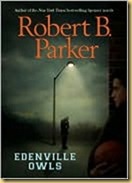 This book has it all: drama, suspense, sports, history, romance. Bobby and his friends play basketball, but since their junior high school doesn’t have a gym, they are an unofficial team –no coach, no uniforms, and they hitchhike to most of the games. When Bobby finds out there’s an extra slot in the local tournament, the Owls really get down to it. Bobby starts hanging around the high school practices to see how they practice, and he tries to get the Owls to do the same drills. The suspense comes into play with their new (and attractive) teacher, Miss Delaney. One day when Bobby is staying after school for detention, he looks out the window and sees a man threatening Miss Delaney. He scares the guy off by yelling out the window, but he just can’t let it go until he finds out who the man is and why he’s hassling Miss Delaney. The ensuing surveillance turns up Nazi connections (the book takes place just at the end of WW II), a secret marriage and a phony identity. The romance comes with Bobby’s best friend, Joanie, who Bobby maybe has more feelings for than he realized. The Owls are great friends –always there for each other, even when they clash about what to do on the basketball court or who is Joanie’s boyfriend. If you’ve read any of Parker’s adult novels about the detective Spenser, you’ll recognize his character in the young Bobby. There’s a ton of historical information inserted in separate sections of the book that really set the scene of the time period. Review by Stacy Church
This book has it all: drama, suspense, sports, history, romance. Bobby and his friends play basketball, but since their junior high school doesn’t have a gym, they are an unofficial team –no coach, no uniforms, and they hitchhike to most of the games. When Bobby finds out there’s an extra slot in the local tournament, the Owls really get down to it. Bobby starts hanging around the high school practices to see how they practice, and he tries to get the Owls to do the same drills. The suspense comes into play with their new (and attractive) teacher, Miss Delaney. One day when Bobby is staying after school for detention, he looks out the window and sees a man threatening Miss Delaney. He scares the guy off by yelling out the window, but he just can’t let it go until he finds out who the man is and why he’s hassling Miss Delaney. The ensuing surveillance turns up Nazi connections (the book takes place just at the end of WW II), a secret marriage and a phony identity. The romance comes with Bobby’s best friend, Joanie, who Bobby maybe has more feelings for than he realized. The Owls are great friends –always there for each other, even when they clash about what to do on the basketball court or who is Joanie’s boyfriend. If you’ve read any of Parker’s adult novels about the detective Spenser, you’ll recognize his character in the young Bobby. There’s a ton of historical information inserted in separate sections of the book that really set the scene of the time period. Review by Stacy Church
Thursday, April 21, 2011
Review of Flirt Club by Cathleen Daly
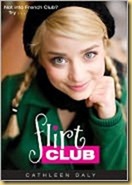 If you love Angus, Thongs and Full-Frontal Snogging, this is the book for you. Flirt Club consists mostly of letters back and forth between Isabelle and Annie (also known as Cisco and the Bean), with a few journal entries thrown in for good measure. Cisco and the Bean share the hilarious disability of being unable to flirt with boys. As Bean (Agent #66) writes to Cisco (Agent #88) “SO, I think our next undercover, secret-agent-girl operation should be learning how to FLIRT! What do you think, No. 88? …let’s see if we can adopt identities that don’t clam up, blush, stutter, sputter, and basically run away and die around boys…Write me back if you can, my little pork chop.” The writing is very funny, and of course, the voices of the two girls are much too clever to be the voices of two actual girls, but that’s ok because it’s so darn funny. At the end of the first meeting, here’s what the girls wrote:
If you love Angus, Thongs and Full-Frontal Snogging, this is the book for you. Flirt Club consists mostly of letters back and forth between Isabelle and Annie (also known as Cisco and the Bean), with a few journal entries thrown in for good measure. Cisco and the Bean share the hilarious disability of being unable to flirt with boys. As Bean (Agent #66) writes to Cisco (Agent #88) “SO, I think our next undercover, secret-agent-girl operation should be learning how to FLIRT! What do you think, No. 88? …let’s see if we can adopt identities that don’t clam up, blush, stutter, sputter, and basically run away and die around boys…Write me back if you can, my little pork chop.” The writing is very funny, and of course, the voices of the two girls are much too clever to be the voices of two actual girls, but that’s ok because it’s so darn funny. At the end of the first meeting, here’s what the girls wrote:
“In Conclusion/Things we have learned at Flirt Club:
1.Smiling,questions/showing interest are a good start. (The worst thing that can happen is that someone feels cared about.)
2. Hair flipping is not a good approach for either of us.
3. I am considering throwing things (that don’t hurt) at an ADT (Actual Designated Target).
Review by Stacy Church
Review of Rose Sees Red by Cecil Castellucci
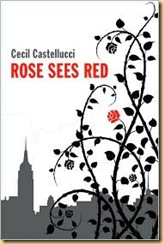 Despite a somewhat melodramatic beginning, this is a really engaging story about two teen-aged girls living in New York City: Rose, an American girl and Yrena, a Russian girl. They’ve lived next door to each other for a couple of years, and although Rose and her brother, Todd, see Yrena in the mornings (they leave for school at the same time), and Rose and Yrena have watched each other through their bedroom windows, they’ve never met until the evening Yrena climbs through Rose’s bedroom window and is suddenly there. Rose’s brother spends a lot of time fantasizing about Yrena, and they’ve both made jokes about the KGB and CIA agents who stand watch outside Yrena’s house, It’s the 1980’s, and the Cold War is on between Russia and the US. Rose goes to Performing Arts High School where she studies ballet. Yrena studies ballet also, but has no passion for it, although her dancing is brilliant. The entire book takes place in the 24 hours after Yrena comes to Rose’s house –they sneak out to join some other Performing Arts students on the steps of the Metropolitan Museum of Art because Yrena wants to go to a real American party. The funny thing is that Rose is completely withdrawn socially. She decided to go to Performing Arts HS even though her best friend, Daisy, told her their friendship was over if she didn’t go to Science with her. For once Rose stood up for herself and decided to do what she loved, which was dance. She’s so afraid of being hurt in another friendship that she makes no effort to make any friends at her new school, and it’s only because she’s trying to show Yrena a good tiime that she gets out of the house. The girls’ disappearance practically causes an international incident. Rose Sees Red opens a window into a time period not written about very often in children’s or young adult literature, and readers will probably find it hard to believe that Russia and the US were so openly distrustful of each other. Review by Stacy Church
Despite a somewhat melodramatic beginning, this is a really engaging story about two teen-aged girls living in New York City: Rose, an American girl and Yrena, a Russian girl. They’ve lived next door to each other for a couple of years, and although Rose and her brother, Todd, see Yrena in the mornings (they leave for school at the same time), and Rose and Yrena have watched each other through their bedroom windows, they’ve never met until the evening Yrena climbs through Rose’s bedroom window and is suddenly there. Rose’s brother spends a lot of time fantasizing about Yrena, and they’ve both made jokes about the KGB and CIA agents who stand watch outside Yrena’s house, It’s the 1980’s, and the Cold War is on between Russia and the US. Rose goes to Performing Arts High School where she studies ballet. Yrena studies ballet also, but has no passion for it, although her dancing is brilliant. The entire book takes place in the 24 hours after Yrena comes to Rose’s house –they sneak out to join some other Performing Arts students on the steps of the Metropolitan Museum of Art because Yrena wants to go to a real American party. The funny thing is that Rose is completely withdrawn socially. She decided to go to Performing Arts HS even though her best friend, Daisy, told her their friendship was over if she didn’t go to Science with her. For once Rose stood up for herself and decided to do what she loved, which was dance. She’s so afraid of being hurt in another friendship that she makes no effort to make any friends at her new school, and it’s only because she’s trying to show Yrena a good tiime that she gets out of the house. The girls’ disappearance practically causes an international incident. Rose Sees Red opens a window into a time period not written about very often in children’s or young adult literature, and readers will probably find it hard to believe that Russia and the US were so openly distrustful of each other. Review by Stacy Church
‘
Friday, April 8, 2011
Review of Cloaked by Alex Flinn
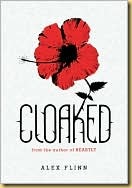 Not a lot of books can carry off a story based around a teenaged shoe repairman, but that part of the story isn’t the problem with Cloaked. I love the details about Johnny’s life running his family’s shoe repair business in a swanky hotel in Miami. Johnny’s family is poor, especially since his dad disappeared, and he’s trying to keep things going so his mom can pay the rent, and, he knows a lot about shoes. It’s not often you hear a teenaged boy talk about Manolo Blahniks. And on the sly he designs his own shoes and makes up models with the scraps of leather left over from repairs. The problem with the story comes more with the fairy tale aspect. Of course there’s a quest, with the promise of the visiting princess’s hand in marriage if he can find the frog her brother was turned into by the evil witch. The princess’s accent is tiresome. The talking swans are cool (they used to be human, so with special earbuds Johnny can understand what they’re saying). I don’t mind the travelling cloak, or how clueless Johnny is about who he really likes. But honestly, the plot is so hard to follow there were times when I went back and reread to see if I missed something that would explain what was going on. I enjoyed the first half of the book, so maybe if you’re a big fan of Alex Flinn’s other books, you can hang in there through the whole thing. Review by Stacy Church
Not a lot of books can carry off a story based around a teenaged shoe repairman, but that part of the story isn’t the problem with Cloaked. I love the details about Johnny’s life running his family’s shoe repair business in a swanky hotel in Miami. Johnny’s family is poor, especially since his dad disappeared, and he’s trying to keep things going so his mom can pay the rent, and, he knows a lot about shoes. It’s not often you hear a teenaged boy talk about Manolo Blahniks. And on the sly he designs his own shoes and makes up models with the scraps of leather left over from repairs. The problem with the story comes more with the fairy tale aspect. Of course there’s a quest, with the promise of the visiting princess’s hand in marriage if he can find the frog her brother was turned into by the evil witch. The princess’s accent is tiresome. The talking swans are cool (they used to be human, so with special earbuds Johnny can understand what they’re saying). I don’t mind the travelling cloak, or how clueless Johnny is about who he really likes. But honestly, the plot is so hard to follow there were times when I went back and reread to see if I missed something that would explain what was going on. I enjoyed the first half of the book, so maybe if you’re a big fan of Alex Flinn’s other books, you can hang in there through the whole thing. Review by Stacy Church
Review of See What I See by Gloria Whelan
